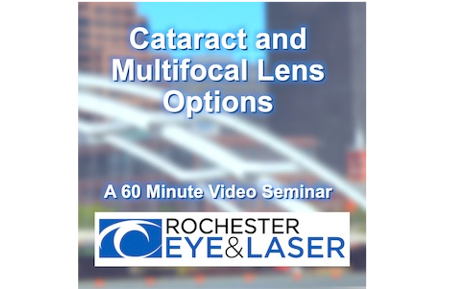Cataract Surgery Options in Rochester
In this video Kim Fullone, Former Director of Clinical Services, and Dr. Ken Lindahl explain Cataracts, Cataract Surgery, newer LASER cataract...

 Most cataracts develop slowly over time and will not greatly affect eyesight in the early stages. Cataracts are the clouding of the lens of the eye either due to natural aging or injury. Proteins and fibers in the lens of the eye begin to break down causing the formation of the cataract to create a haziness or blurriness in vision.
Most cataracts develop slowly over time and will not greatly affect eyesight in the early stages. Cataracts are the clouding of the lens of the eye either due to natural aging or injury. Proteins and fibers in the lens of the eye begin to break down causing the formation of the cataract to create a haziness or blurriness in vision.
How do you know what type of cataract you have? Location of the cataract will help you to know what kind of cataract has developed on your eye. The four types of cataracts are nuclear, cortical, posterior subcapsular, and congenital.
Nuclear cataracts affect the center of the eye. The lens of the eye is made up of water and protein fibers. During the aging process, more fibers begin to grow pushing the older fibers toward the nucleus, or center of the eye. The proteins in the fibers begin to clump causing the central region of the eye to become denser vision and vision to become unclear. Nuclear cataracts take on a yellowish hue and eventually turn brown. Advanced yellowing or browning of the lens can lead to difficulty distinguishing shades of color.
Cortical cataracts affect the edges of the lens of the eye. These types of cataracts develop as whitish, wedge-shaped streaks. As the cataract progresses, those streaks move closer to the center of the eye. Cortical cataracts are opaque and affect peripheral vision first. Aside from gradual blurring vision, the most common symptom of a cortical cataract is glaring lights at night or being extra sensitive to bright sunlight or artificial light.
Posterior subcapsular cataracts affect the back of the lens of the eye. Because the dense clumping creates a small opaque clouding in the path of light, reading can become difficult. Bright lighting can cause glares or halos that also affect the quality of vision. Most people find that they can only tolerate dim lighting with posterior subcapsular cataracts.
Congenital cataracts are the easiest to identify of all cataract types as congenital cataracts are a rare defect of the eyes present at birth. Congenital cataracts can be genetic or can develop due to intrauterine infection or certain conditions such as muscular dystrophy, galactosemia, neurofibromatosis type 2, or rubella.
While cataracts cannot be prevented, cataract surgery has a high success rate of 99% in improving eyesight. If you are concerned you may have developed a cataract, the Rochester Eye and Laser Center offers a variety of testing options to diagnose and treat all kinds of eye conditions.
Let us help improve your vision with a comprehensive eye exam by calling 585-232-2560.
Learn more about cataracts at www.rochestereyecenter.com/laser-cataract-surgery.

In this video Kim Fullone, Former Director of Clinical Services, and Dr. Ken Lindahl explain Cataracts, Cataract Surgery, newer LASER cataract...

Cataracts are the leading cause of blindness in the United States, according toPrevent Blindness America, which declared June as Cataract Awareness...

PanOptix® Trifocal Intraocular Lens (IOL), the first and only trifocal lens for U.S. patients undergoing cataract surgery. PanOptix is clinically...